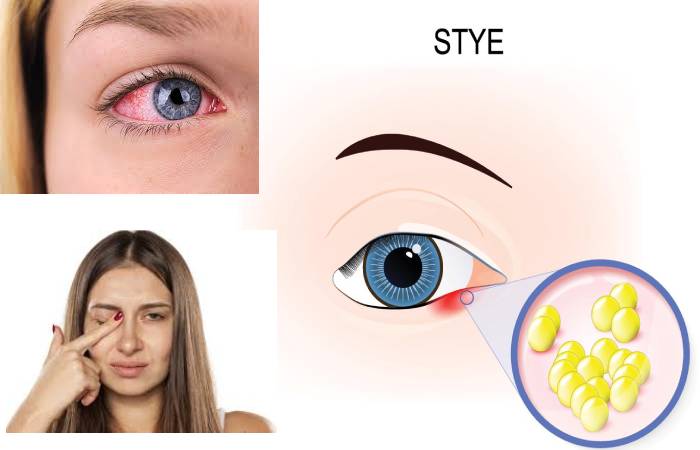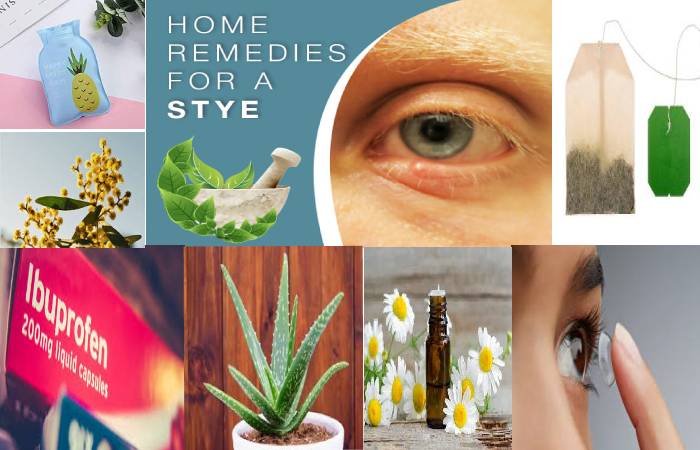Table of Contents
Stye Definition
A stye is a red, painful rash on the eyelid caused by a swollen oil gland on the eyelid’s edge, just where it contacts the eyelashes.
The swollen gland takes on a pimple-like shape, swollen, reddish, and is often tender to the touch.
Styes bear a remarkable resemblance to common acne pimples. Next, we are going to see the leading causes and remedies for curing a stye.
Why does Stye Occur?
When a stye occurs in one of the eyelids’ sebaceous glands, we get a stye because the bacteria multiply within the blocked gland. These bacteria that cause the infection are usually Staphylococcus aureus.
If the sebaceous gland becomes completely clogged, the Stye can develop into a chalazion, common to cause vision problems, such as blurred vision.
Although styes can occur at any age, older people are more likely to have them.
They are associated with eye problems that are more common in the elderly such as blepharitis (inflammation of the eyelids), papillomas (flesh-coloured bumps or pink), and cysts (small fluid-filled sacs).
What are the symptoms of Stye?

The symptoms of Stye are as follows:
- Red and swollen bump is the main symptom.
- A sensation of sand in the eyes or that a foreign body has entered.
- Sensitivity to light.
- Tenderness or pain in the eyelid
- If it grows too large and turns into a chalazion, it can obstruct vision.
What are the Types of Stye?

Styes classifies according to the areas where they develop:
Internal Stye: They grow on the inside of the eyelid.
External Stye: They appear at the base of the eyelashes.
Diagnosis of Stye
The ophthalmologist usually diagnoses stye by performing a simple visual exam. It is common for the specialist to use various devices to examine the eyelid and cornea if there has been damage.
Home Remedies for a Stye

When you wake up one morning with a Stye, and you don’t know what to do, follow the tips below to cure it as quickly as possible.
1. Use a Cloth with Warm Water
Dip a clean cloth with warm (not hot) water. Drain it, so it doesn’t drip, then hold it over the eye for about 5-10 minutes.
You can repeat this at least 3 or 4 times per day. The heat helps dissolve the pus and allow the Stye to drain naturally.
2.Compress a Tea Bag
Instead of using a warm washcloth, use a hot tea bag. Green tea helps reduce swelling and has some antibacterial properties.
To do this, boil the water and dip the teabag in a mug as if you were making tea to drink.
Then let the tea steep for a minute, and wait for the tea bag to cool satisficing to moisten a cloth and place it over your eye. Afterwards, you should keep it in the area for about 5 to 10 minutes.
3. Take Pain Relievers
Taking a pain reliever as ibuprofen can help relieve when the Stye is painful. Read the instructions for use to make sure you are taking the correct dose.
4. Use the Power of the Acacia
If you don’t want to take medication, you may ease stye pain with acacia. Place many acacia leaves in a cup of hot water and let the infusion cool. Then it is warm, wet it and place on the eye for 5 to 10 minutes two or three times a day.
5. Use Chamomile
Another infusion that you can use is Chamomile. Follow the previous point’s steps and place a cloth on the eye after moistening it in the warm solution. Once placed on the eye, leave the fabric on for 5-10 minutes two or three times a day.
6. Put Aloe Vera on
Aloe vera is the best home remedies out there. You have to cut one of the leaves and open it in the centre. Then. Wet a cotton ball so that it impregnate with the transparent liquid that the plant secretes. Run the cotton over the eye twice a day.
7. Cucumber
Cucumbers have a natural calming effect, which is why they are ideal for treating styes. Their cooling and astringent properties are useful for masks and are also excellent for relieving Stye’s characteristic symptoms.
Therefore, cut a cucumber into slices and place them on the area to be treated. It will reduce inflammation and painful symptoms.
8. Clean with Mild Soap and Water
She is avoiding harsh, synthetic chemicals if cleaning the eye area. Instead, ingredients should be hypoallergenic and non-irritating.
The skin around the eyes is much thick than the face. Therefore, you need to be prudent to use the products you apply to the eye area.
It uses OCuSOFT to cleanse eyelids because it’s productive against bacteria commonly start on the eyelid. Its formula effectively kills seven different strains of bacteria.
You can take a tear-free baby shampoo and mix it with a bit of warm water. Use it with a cotton swab to gently wipe off your eyelids. You can do this every day until it goes.
Cleaning your eyelids helps stop future styes. Another way is to use a saline solution. It helps promote drainage and break down bacterial membranes.
9. Avoid Apply Makeup and Contact Lenses
Avoid applying to makeup when you have a Stye. Makeup can pain the eye even more and delay the healing process. You can also move bacteria to your makeup and tools and grow the infection to your other eye.
Wash your reusable brushes usually. Send out any eye products that are over three months aged.
When you wear contact lenses, stick with glasses until your Stye heels. Bacteria from the Stye can obtain onto the contacts and grow the infection.
Convert to a new set of contact lenses when the Stye heals to prevent reinfection.
10. Use Antibiotic Ointments
To help a mild stye go away, you can apply an OTC antibiotic ointment to the affected area, but see a dermatologist or eye doctor to treat a stye that:
- It is excessively painful.
- Interferes with vision
- Won’t go away with OTC treatment
- Use these OTC ointments, pull the affected eye’s lid, and apply about a quarter-inch of cream inside the eyelid.
Conclusions
Styes usually causes by bacteria, although this is not the only reason for their appearance. Generally, the little ones tend to suffer it more frequently.
Despite not being a severe medical phenomenon, it is always preferable to go to the doctor for advice and give you a professional diagnosis.
When you wake up one morning with one, always keep your hands clean and don’t rub your eye.
Of course, don’t try to tear it off because you could source an infection. Finally, you follow the advice suggest above, and you may lower your symptoms.

